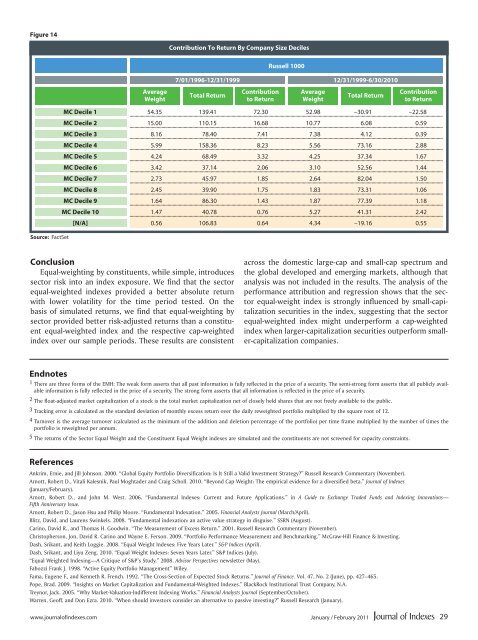Improved Beta? - IndexUniverse.com
Improved Beta? - IndexUniverse.com
Improved Beta? - IndexUniverse.com
Create successful ePaper yourself
Turn your PDF publications into a flip-book with our unique Google optimized e-Paper software.
Figure 14<br />
Contribution To Return By Company Size Deciles<br />
Trading<br />
Symbol<br />
Average<br />
Weight<br />
Russell 1000<br />
7/01/1996-12/31/1999 12/31/1999-6/30/2010<br />
Total Return<br />
Contribution<br />
to Return<br />
Average<br />
Weight<br />
Total Return<br />
Contribution<br />
to Return<br />
MC Decile 1 54.35 139.41 72.30 52.98 –30.91 –22.58<br />
MC Decile 2 15.00 110.15 16.68 10.77 6.08 0.59<br />
MC Decile 3 8.16 78.40 7.41 7.38 4.12 0.39<br />
MC Decile 4 5.99 158.36 8.23 5.56 73.16 2.88<br />
MC Decile 5 4.24 68.49 3.32 4.25 37.34 1.67<br />
MC Decile 6 3.42 37.14 2.06 3.10 52.56 1.44<br />
MC Decile 7 2.73 45.97 1.85 2.64 82.04 1.50<br />
MC Decile 8 2.45 39.90 1.75 1.83 73.31 1.06<br />
MC Decile 9 1.64 86.30 1.43 1.87 77.39 1.18<br />
MC Decile 10 1.47 40.78 0.76 5.27 41.31 2.42<br />
[N/A] 0.56 106.83 0.64 4.34 –19.16 0.55<br />
Source: FactSet<br />
Conclusion<br />
Equal-weighting by constituents, while simple, introduces<br />
sector risk into an index exposure. We find that the sector<br />
equal-weighted indexes provided a better absolute return<br />
with lower volatility for the time period tested. On the<br />
basis of simulated returns, we find that equal-weighting by<br />
sector provided better risk-adjusted returns than a constituent<br />
equal-weighted index and the respective cap-weighted<br />
index over our sample periods. These results are consistent<br />
across the domestic large-cap and small-cap spectrum and<br />
the global developed and emerging markets, although that<br />
analysis was not included in the results. The analysis of the<br />
performance attribution and regression shows that the sector<br />
equal-weight index is strongly influenced by small-capitalization<br />
securities in the index, suggesting that the sector<br />
equal-weighted index might underperform a cap-weighted<br />
index when larger-capitalization securities outperform smaller-capitalization<br />
<strong>com</strong>panies.<br />
Endnotes<br />
1 There are three forms of the EMH: The weak form asserts that all past information is fully reflected in the price of a security. The semi-strong form asserts that all publicly available<br />
information is fully reflected in the price of a security. The strong form asserts that all information is reflected in the price of a security.<br />
2 The float-adjusted market capitalization of a stock is the total market capitalization net of closely held shares that are not freely available to the public.<br />
3 Tracking error is calculated as the standard deviation of monthly excess return over the daily reweighted portfolio multiplied by the square root of 12.<br />
4 Turnover is the average turnover (calculated as the minimum of the addition and deletion percentage of the portfolio) per time frame multiplied by the number of times the<br />
portfolio is reweighted per annum.<br />
5 The returns of the Sector Equal Weight and the Constituent Equal Weight indexes are simulated and the constituents are not screened for capacity constraints.<br />
References<br />
Ankrim, Ernie, and Jill Johnson. 2000. “Global Equity Portfolio Diversification: Is It Still a Valid Investment Strategy?” Russell Research Commentary (November).<br />
Arnott, Robert D., Vitali Kalesnik, Paul Moghtader and Craig Scholl. 2010. “Beyond Cap Weight: The empirical evidence for a diversified beta.” Journal of Indexes<br />
(January/February).<br />
Arnott, Robert D., and John M. West. 2006. “Fundamental Indexes: Current and Future Applications.” in A Guide to Exchange Traded Funds and Indexing Innovations—<br />
Fifth Anniversary Issue.<br />
Arnott, Robert D., Jason Hsu and Philip Moore. “Fundamental Indexation.” 2005. Financial Analysts Journal (March/April).<br />
Blitz, David, and Laurens Swinkels. 2008. “Fundamental indexation: an active value strategy in disguise.” SSRN (August).<br />
Carino, David R., and Thomas H. Goodwin. “The Measurement of Excess Return.” 2001. Russell Research Commentary (November).<br />
Christopherson, Jon, David R. Carino and Wayne E. Ferson. 2009. “Portfolio Performance Measurement and Benchmarking.” McGraw-Hill Finance & Investing.<br />
Dash, Srikant, and Keith Loggie. 2008. “Equal Weight Indexes: Five Years Later.” S&P Indices (April).<br />
Dash, Srikant, and Liyu Zeng. 2010. “Equal Weight Indexes: Seven Years Later.” S&P Indices (July).<br />
“Equal Weighted Indexing—A Critique of S&P’s Study.” 2008. Advisor Perspectives newsletter (May).<br />
Fabozzi Frank J. 1998. “Active Equity Portfolio Management” Wiley.<br />
Fama, Eugene F., and Kenneth R. French. 1992. “The Cross-Section of Expected Stock Returns.” Journal of Finance. Vol. 47, No. 2 (June), pp. 427–465.<br />
Pope, Brad. 2009. “Insights on Market Capitalization and Fundamental-Weighted Indexes.” BlackRock Institutional Trust Company, N.A.<br />
Treynor, Jack. 2005. “Why Market-Valuation-Indifferent Indexing Works.” Financial Analysts Journal (September/October).<br />
Warren, Geoff, and Don Ezra. 2010. “When should investors consider an alternative to passive investing?” Russell Research (January).<br />
www.journalofindexes.<strong>com</strong> January / February 2011<br />
29

















